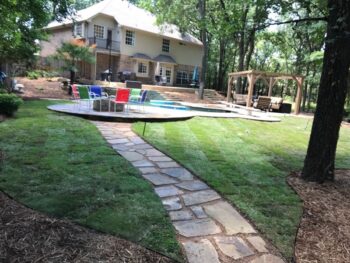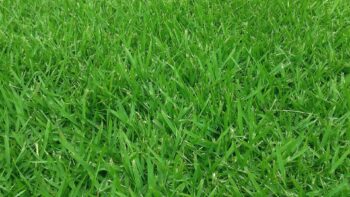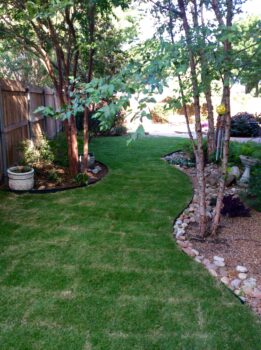
Wondering what the best grass for shade in North Texas is? One of the challenges lawn enthusiasts face is finding the right grass to grow in shaded areas. Lack of sunlight leads to thin and patchy grass.
However, there are grass types that do well in shaded areas. With the right care and maintenance, they provide a beautiful and healthy, lush lawn. All grass types do require some amount of sun to thrive. Luckily, some types require less sun than others.
Choosing the best grass for shade requires an understanding of the specific needs of each grass and the unique growing conditions in North Texas.
When you’re done reading this blog post, you may realize that you need a different grass type for your lawn. We are ready to help. Our sod installation is our most requested service. Now, we will explore the types of grass well-suited for shady areas in North Texas. Read on and understand how to cultivate and maintain a healthy and vibrant lawn.
St Augustine Grass

This type of grass has a deep green color that thrives in both sun and shade. St Augustine grass also has broad leaves that efficiently capture sunlight making it more tolerant to shaded areas. It also has a dense growth habit preventing weed growth in areas with limited sunlight.
St Augustine is also adaptable to a range of soil types including clay or sandy soils, which are common in North Texas. It has a strong root system which allows it to absorb moisture and nutrients efficiently. Lawns need nutrients to help them grow. We offer lawn fertilization as one of our services.
The grass is low maintenance making it a great choice for homeowners who want a beautiful and lush lawn without investing a lot of time or effort. This grass types requires 3-4 hours of daily sunlight.
Texas A&M University has published a pdf titled, “Maintaining St. Augustine Grass Lawns,” which has valuable insight for homeowners interested in St. Augustine turf.

Zoysia
This is another great choice of grass for people with shady yards. It has a high tolerance for heat and drought. It also has the ability to thrive in full sun and partial shade.
Thanks to its deep root system root system, it requires less watering and fertilization making it a low maintenance turf.
Zoysia grass is also popular for its thick, dense growth which helps to crowd out weeds. It has a lush green color and fine texture. Which makes it an attractive choice for lawns. This turfgrass requires 4 hours of daily sunlight in order to thrive.
Casey Reynolds, PhD published an information sheet that lists facts about Zoysia grass.
Tips for Growing Grass in Shady Areas
- Prune or remove trees: trim back the overhanging branches and thin out trees to help let more light through to the ground. This gives the grass the required amount of sunlight allowing it to thrive. Another option is completely remove the trees.
- Plant a grass alternative: in areas with heavy shade where grass struggles to grow, ground covers work well. These include moss, hostas, or creeping thyme.
- Check soil conditions: soil with poor drainage prevents grass from growing well in shady areas. Test your soil before you plant and amend it with organic matter like topsoil or compost.
- Choose the right grass type: Grasses like St Augustine and Zoysia do better in partial shade than Bermuda, which requires full sun.
- Maintain proper watering and fertilization: Even the shade loving grasses require adequate water and nutrients to survive and thrive. Water regularly and fertilize properly for your grass type.
Wrapping Up

Growing grass in shady areas requires some effort. Though grass types like St Augustine and Zoysia do well in shade areas, you have to properly water and fertilize them for them to thrive. Check out our weed control service page.
Another thing to remember is all grass types need some amount of sunlight to grow. If you want a lush and healthy lawn, understand your area and the soil conditions. Plant grass types suitable for that specific area.
